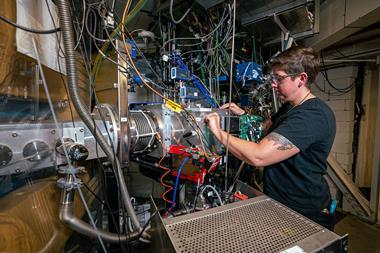The limit of known half-lives of superheavy massive nuclei has been pushed down by two orders of magnitude with the observation of the half-life of a neutron deficient rutherfordium isotope. In measuring a half-life so short, researchers demonstrated how certain excited states have longer half-lives, thus fleshing out our understanding of fission.
Within a heavy atom a delicate balance is at play, offsetting the Coulomb repulsion of the positively charged protons with just enough attractive nuclear strong forces to stop the nucleus bursting apart. Here, neutrons play a key role providing additional nucleons for the strong force to act on without dialling up the Coulomb repulsion at the same time.
Neutrons become particularly important for ‘superheavy elements’, meaning those with 104 protons or more. Although too large to form in nature, or resist fission decay for long, since the 1960s scientists have tasked themselves with adding ever more of these superheavy elements to the periodic table. However, it takes at least 10-14s for the electrons to organise around the newly formed nucleus – should it decay before that point, it cannot be considered an atom, so no new element has been formed.
Another way of investigating the limit of stability is to look at neutron deficient isotopes, thus determining the ‘isotopic border’. With this in mind, Khuyagbaatar Jadambaa led a team of researchers from the GSI Helmholtz Centre for Heavy Ion Research, Johannes Gutenberg University Mainz and the Helmholtz Institute Mainz in Germany to study rutherfordium-252, the most depleted known isotope of the element.
According to theory, quantum shell effects prolong the half-life against fission decay of rutherfordium-252 to around 650 nanoseconds. Although Jadambaa’s initial extrapolations from the measured half-life of rutherfordium-253 positioned the half-life of rutherfordium-252 in picoseconds – close to the isotopic border – subsequent refinements pointed towards a half-life of about 100 nanoseconds.
‘I was thinking that, okay, the story is more or less finished; the classical fission theory is safe,’ says Jadambaa. However, roughly five months later, researchers in France and Russia led by Araceli Lopez-Martens at IJClab, Université Paris Saclay reported a picosecond (10-12s) value extrapolated from measurements of the lighter element nobelium. The only way to really settle the mismatch was to measure it directly.
Despite formation of rutherfordium-252 being an extremely rare event requiring about 1012 particles to collide per second for around two weeks, Jadambaa and colleagues were able to form it by bombarding lead with a beam of titanium-50 accelerated to 10% the speed of light. The really tricky bit was measuring the half-life since it takes a microsecond – many times longer than its lifetime – to separate the newly formed isotope.
Thankfully the experiment formed rutherfordium-252 in an excited state, which has a half-life of microseconds, allowing time for it to be extracted and the subsequent fission decay monitored. They obtained values of 13 microseconds and 60 nanoseconds for the fission decay half-life of rutherfordium-252 in the excited and ground states.
Lopez-Martens, who was not involved in the current work, notes that their work demonstrates that highly excited states provide opportunities ‘for the synthesis and observation of heavier deformed superheavy nuclei’. However, she remains sceptical as to whether ‘the 60 nanosecond state is indeed the ground state’ and not another excited state.
Jadambaa and his team previously looked at nobelium-250 excited states and determined that ‘the probability of populating such a second and higher-lying isomeric state was very low’. As such, he and his team are confident that the result does align with theoretical predictions.
‘We don’t need to throw away our current theory,’ he says, adding that they do nonetheless need more experimental data to assist theoreticians in tuning the fission model. Next they hope to exploit similar effects to investigate seaborgium.
References
J Khuyagbaatar et al, Phys. Rev. Lett., 2024, 134, 022501 (DOI: 10.1103/PhysRevLett.134.022501)

















No comments yet